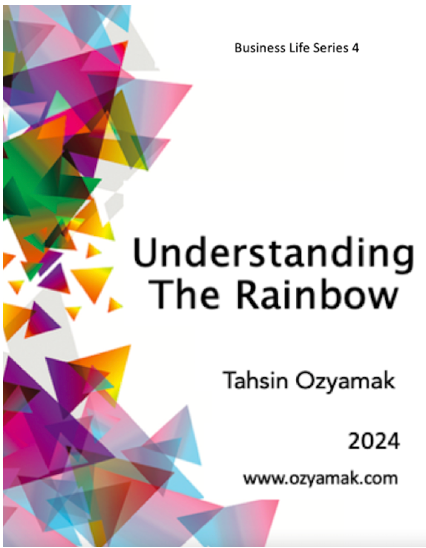Understanding the rainbow İş Yaşam Serisi 4
KitaplarIntroduction
Capturing the rainbow is the never-ending dream of all innocence. We seek refuge in it, yet we can never fully step beneath it, nor can we withdraw ourselves from its allure. We gaze in admiration at the sky, captivated by the harmony of those colors united. We even run towards it, hoping to grasp that innocence and pass beneath it, but as we run, it distances itself from us. When the sky returns to a single hue, the rainbow unravels from its waist, and we strive to find our place under this single color. We dreamily await the days when the sky will once again gird itself with the rainbow.
There are two distinct aspects concerning colors: one is the pursuit of colors that can represent us personally, and the other is the ability to create a rainbow through good management while preserving individual differences.
If we begin with colors, individuals are searching for their own hues everywhere. The workplace and its manager mix these colors on a palette to create harmony.
A new journey called governance has begun in the present day, stemming from the concepts of managing and being managed. You might ask, “Where did this governance come from when we haven’t even fully implemented management in our lives yet?”
Governance, as defined by the Turkish Language Association (TDK), is described as “joint and collaborative management within organizations, involving the shared use of
administrative, economic, and political authority in both public and private institutions” (source).
We can say that Ahilik, a part of our historical business culture, the Total Quality Management of yesterday, and today’s ISO standards are the most beautiful examples of this pursuit.
As a continuation of my book "A Drop of Water in Our Working Life" published in 2017, I wanted to address management systems in this book. I aimed to look at management systems not solely from the focus of professional life but from the perspective of collaborative governance and quality life, which affect all aspects of our lives, and to share my experiences from this viewpoint.
I began my work by examining the applications of governance in families, public and private institutions, and businesses, as well as the expectations of politicians, managers, the public, students, and others. I was aware that bringing these elements together would be a very serious endeavor. As I began to examine Ahilik, the legacy of our ancestors that would form the backbone of this book, I realized that it is the foundation of today’s standards.
When I endeavored to explain the governance process on its own, I found that this effort was insufficient. I concluded that it could only be fully conveyed through the Ahilik system. For this reason, I listened to real-life experiences that would shed light on the Ahilik system and examined the written and visual resources in this field.
I read and listened to the experiences of esteemed elders and friends, whose views I deeply respect, who have conducted significant research on governance. I recorded their insights, believing that bringing these thoughts to the reader would be an important step in explaining the concept of governance.
I am also curious about the outcome that will emerge from this collaboration. I hope to convey the connection between the concept of governance and Ahilik to you accurately and freely.
In any case, the concept of collaborative governance has been a subject of discussion for centuries and is one that we have struggled to resolve. Due to the importance of this topic, I approached the preparation of this book with the awareness of the significant responsibility I was shouldering. Despite this, I will never cease to ponder these matters. Beyond making this effort a part of our daily lives, I believe we owe it to those who will inherit our future.

